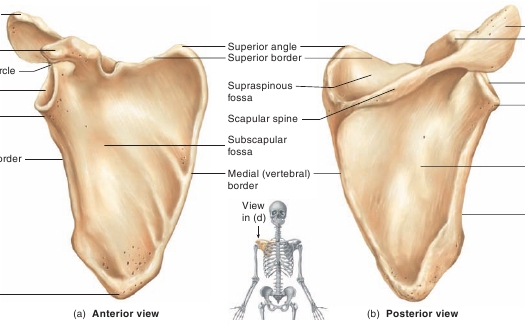226
PART 2 Support and Movement

Acromion process
Coracoid process
Supraglenoid tubercle
Glenoid cavity
Infraglenoidtubercle
Lateral (axillary) border
Acromion processCoracoid process
Glenoid cavity
Infraglenoidtubercle
Infraspinous fossa
Lateral (axillary)border
Inferior angle

Acromialend
(c)
Superior view
(d)
Superior view
FIGURE 7.23
Right Scapula and Clavicle
(
a
) Right scapula, anterior view. (
b
) Right scapula, posterior view. (
c
) Right clavicle, superior view. (
d
) Photograph of the right scapula and clavicle from a superiorview, showing the relationship between the distal end of the clavicle and the acromion process of the scapula.
inferior to the spine. The deep, anterior surface of the scapulaconstitutes the
subscapular fossa.
The smaller
coracoid
(mean-ing “shaped like a crow’s beak”)
process
provides attachments forsome shoulder and arm muscles. A
glenoid
(gl ē ′noyd, glen′oyd)
cavity,
located in the superior lateral portion of the bone, articu-lates with the head of the humerus.The clavicle (see figures 7.20, 7.22, and 7.23
c
) is a longbone with a slight sigmoid (S-shaped) curve. It is easily seen andfelt in the living human (see figure 7.21). The lateral end of theclavicle articulates with the acromion process, and its medial endarticulates with the manubrium of the sternum. These articulationsform the only bony connections between the pectoral girdle andthe axial skeleton. Because the clavicle holds the upper limb awayfrom the body, it facilitates the limb’s mobility.
Predict 4
Sarah fell off the trampoline in her backyard. She was crying and holdingher right shoulder, so her mother took her to the emergency room. Dr.Smart diagnosed a broken collarbone (clavicle), based on the position ofSarah’s right upper limb. Explain.
Arm
The arm, the part of the upper limb from the shoulder to theelbow, contains only one bone, the
humerus
(figure 7.24). Thehumeral
head
articulates with the glenoid cavity of the scapula.The
anatomical neck,
immediately distal to the head, is almostnonexistent; thus, a surgical neck has been designated. The
surgical neck
is so named because it is a common fracture site